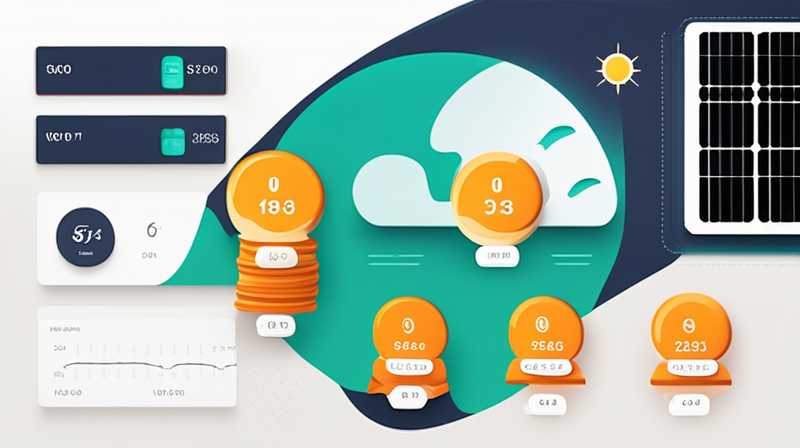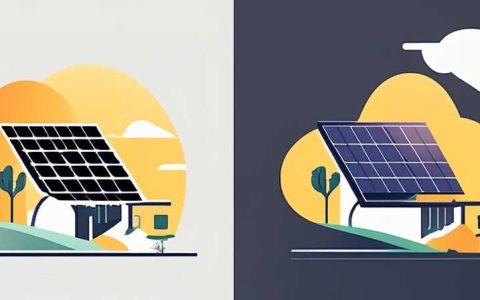
1. A solar panel typically weighs between 40 to 60 pounds, depending on its size and type, 2. Most standard solar panels are about 2.5 to 4 feet tall and 5 to 6 feet long, 3. Weight can vary based on materials used, like silicon, glass, and aluminum, 4. Understanding weight is essential for installation and structural considerations.
When considering the installation of solar panels, weight emerges as a critical factor influencing various aspects of the project. The typical solar panel weighs between 40 to 60 pounds, a range influenced by its dimensions and the materials employed in its construction. Standard panels usually measure between 2.5 to 4 feet in height and 5 to 6 feet in length, presenting a considerable amount of mass that must be accounted for during installation. Furthermore, the materials that comprise the panel, including silicon for photovoltaic cells, glass for protection, and aluminum for framing, also contribute to the overall weight, leading to variability among different models and brands.
Understanding the implications of the weight of solar panels is essential for homeowners and installers alike. Support structures, especially roofs, must be evaluated to ensure they can withstand the cumulative weight of the panels along with any additional components such as wiring and inverters. Additionally, transfer and positioning of these units during installation require specialized equipment due to their weight, which may impact the timeline and costs associated with the installation process. Each specific application—ranging from residential rooftops to larger commercial setups—demands careful consideration of how the individual panel’s weight interacts with local building codes and structural integrity.
1. UNDERSTANDING THE WEIGHT OF SOLAR PANELS
Solar panels are essential components of renewable energy systems that convert sunlight into electrical energy. The weight of a solar panel is not an arbitrary measure, but rather an important statistic that needs careful analysis. Standard panels, predominantly constructed from silicon cells, are enveloped in tempered glass and are framed with aluminum. This construction contributes to their durability and efficiency, though it also adds significant weight compared to alternative energy solutions.
Diving deeper into the engineering of solar panels reveals that the weight can be determined not only by size but also by type. Different types of solar panels, such as monocrystalline, polycrystalline, and thin-film, exhibit varying weights. Monocrystalline panels tend to weigh more due to their dense structure, which maximizes energy production, while thin-film panels are typically lighter as they employ less material but may require more surface area for installation to achieve the same energy output.
2. FACTORS AFFECTING PANEL WEIGHT
The weight of solar panels is impacted by several factors, including size, material type, and design features. Understanding these aspects provides insight for both consumers and installers. The dimensions of the panels directly correlate to their weight, with larger panels intrinsically having greater mass. The most common residential solar panels are around 60 to 72 cells, affecting not just the weight but also how they are installed and connected.
Choosing material types influences weight as well. Modern solar panels utilize various combinations of materials. For example, advancements in technology have made lighter solar cells possible, allowing for reduced panel weight without sacrificing efficiency. Manufacturers continue to innovate to find a balance between lightweight design and the strength needed to withstand environmental stressors such as wind and hail.
3. INSTALLATION CONSIDERATIONS
When planning the installation of solar panels, understanding their weight becomes paramount. The structural integrity of the installation site must be evaluated and reinforced if necessary. This can mean conducting assessments of roofs to ensure they can support the panels’ cumulative weight adequately. Failure to do so could lead to severe structural damage, and potential injury during severe weather conditions.
Moreover, the logistics of installation require careful planning due to the weight of the units. Lifting and positioning solar panels necessitate appropriate equipment and often a team of trained professionals. This aspect can notably affect overall installation costs and timelines, making it crucial for homeowners to consider these factors when budgeting for solar energy systems.
4. DIFFERENT SOLAR PANEL TYPES AND THEIR WEIGHT
As mentioned, the variety of solar panels available on the market also offer different weights. Monocrystalline panels are recognized for their high efficiency and sleek appearance; however, they typically weigh more due to their dense structure. Conversely, polycrystalline panels, while slightly less efficient, often weigh a bit less due to their manufacturing process, which allows for quick production and inclusion of more affordable materials.
Thin-film solar panels are the lightest among the three, providing significant advantages in terms of flexibility and installation ease, but necessitating greater space for an equivalent energy output compared to their crystalline counterparts. Homeowners must weigh their priorities between cost, efficiency, and weight in selecting the appropriate solar panel type for their applications.
5. REGIONAL WEIGHT REGULATIONS AND CODES
In addition to structural implications, weight regulations specific to solar panel installations vary widely by region. Building codes often dictate not only the weight considerations of the solar panels but also installation methods and the type of supporting structures required. These regulations aim to ensure safety and efficiency, accounting for local climate conditions and architectural styles.
Homeowners should consult local building authorities or a qualified installer familiar with regional regulations. Ensuring compliance not only facilitates the installation process but also helps avoid potential legal and financial repercussions. The specific weight limitations and requirements are part of a broader energy strategy focusing on sustainable development without compromising structural safety.
6. THE FUTURE OF SOLAR PANEL WEIGHT
As technology evolves, the weight of solar panels continues to change. Innovations in material science and engineering are paving the way for lighter and more efficient panels. The rise of alternative materials and manufacturing techniques promises to revolutionize how solar panels are constructed, impacting their overall weight and handling during installation.
This potential for lightweight options opens new avenues, enabling applications that were previously impractical or impossible, such as solar installations on mobile units or structures with limited bearing capacity. Ultimately, advancements in solar technology may lead to increased adoption of renewable energy across diverse environments, influencing consumer choices toward adopting solar solutions.
QUESTIONS ABOUT SOLAR PANEL WEIGHT
HOW DO YOU MEASURE THE WEIGHT OF A SOLAR PANEL?
To accurately measure the weight of a solar panel, the most effective method involves employing a scale calibrated to handle substantial weight. A commercial-grade balance scale is typically recommended for precise measurements, ensuring accuracy when determining the unit’s mass. When utilizing such a scale, it is advisable to consider the panel’s packaging. Removing the panel from its packaging can affect the accuracy of weight; thus, professionals suggest weighing only the panel itself unless the entire unit’s packing needs to be accounted for.
Consideration must also be given to the weight of mounting hardware and other components, which can significantly impact the overall installation weight of the solar power system. To eliminate discrepancies, it may be prudent to cross-reference weights with data sheets provided by manufacturers, which often include the specifications for each model, thus ensuring the accuracy of the measurement and aiding in installation planning.
WHAT FACTORS SHOULD BE CONSIDERED WHEN INSTALLING SOLAR PANELS?
When planning the installation of solar panels, a multifaceted approach is required. Firstly, understanding the weight and structural implications is paramount. The roof or support structure must be capable of bearing the cumulative weight, which includes not only the panels but also necessary mounting systems and related equipment.
Secondly, environmental factors deserve attention—such as wind, rain, and snow load—requiring structural reinforcement if local regulations call for it. It is also necessary to consider orientation and tilt for optimizing sunlight exposure while being mindful of shading from nearby trees or buildings. Additionally, local building codes will dictate specific installation guidelines that must be adhered to. These various considerations will collectively contribute to a successful solar panel installation experience.
WHAT ARE THE BENEFITS OF LOWER WEIGHT SOLAR PANELS?
Opting for lighter solar panels can yield several practical advantages. Lightweight units simplify the logistics involved in installation, requiring less robust structural support, which translates to cost savings. Lighter panels are easier to maneuver and position, reducing labor costs and expediting the installation process.
Moreover, the flexibility introduced by lightweight solar panels enables applications in a broader array of contexts. Homes or buildings with weight limitations, such as those constructed from lighter materials or older structures, can benefit from a solar setup that would be prohibitive with standard-weight panels. Thus, advancements in lightweight solar technology not only promote efficient energy generation but also broaden access to renewable energy.
In summary, the weight of solar panels is a multifaceted subject that intertwines various important factors including construction materials, regional regulations, and application contexts. The typical range sits between 40 to 60 pounds, making awareness of specific weights crucial for effective planning and installation. Understanding how weight impacts installation is vital for anyone considering solar energy. Future innovations promise to further adjust these dynamics, opening new possibilities for integrating solar energy into daily life and extending the reach of this sustainable solution.
Original article by NenPower, If reposted, please credit the source: https://nenpower.com/blog/how-many-pounds-does-a-solar-panel-weigh-2/










